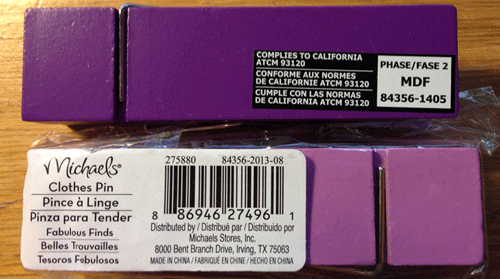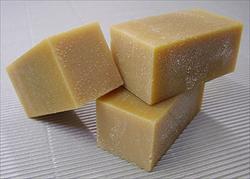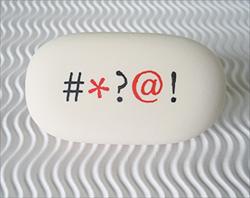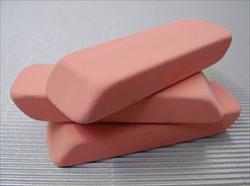
Submitted questions will be posted with my response by the following Tuesday or before.
Submitted comments will be moderated and approved within 24 hours.
False and Misleading Formaldehyde Label
From Debra Lynn Dadd

Yesterday I was in Micheal’s, a national chain craft store, and saw these giant clothespins sitting in a bin as I was waiting in line.
I looked on the label (lower clothespin in photo) to see what they were made of. Since it didn’t give the material, I slipped the packaging open to feel it, and it felt like wood, so I bought two. Purple is my favorite color.
When I got home and opened the package, there was another label inside that was not at all visible with the packaging. It was hidden under the other label!
This label very clearly states the product is made from MDF (medium density fiberboard) and is meets the Phase 2 California standards. I happen to know this is a “low emissions” standard, which is a clue that it is emitting formaldehyde, a carcinogen.
Even after all my years of examining products, I’ve never seen one like this, where the material is hidden and you can only see the material label after you buy the product. I wonder if this is illegal.
Non-toxic eye liner make-up
Question from Cypress
I am doing a big detox program and am more aware than ever of what I put on my skin.
I have not found an eye liner that does not sting or burn, either at the time of use, or later. I got one that was said to be made entirely of fruits and vegetables, though I did wonder how they made it black. It burned my eyes, both when I put it on and, particularly, later.
Does anyone know of an eye liner that really is friendly? I am not now looking for what SOUNDS good, but for actual experience as well.
Debra’s Answer
Well, this really is very individual, but readers, do you have a suggestion?
You might like this. Here’s a recipe to make your own eyeliner, from coconut oil, aloe vera, and charcoal.
This recipe is from a kindle book called All Natural Living: 75 Non-Toxic Recipes For Home & Beauty, which also has a recipe for making your own mascara as well as other beauty products and cleaning products. A deal at only $2.99
Problem with leather in newer car
Question from Jill
I have MCS . My old (and well tolerated) car was totaled in an accident. I finally got so desperate for a car (I live in mountains and have a child), that I bought a 2011 Subaru that had no detailing prior. I thought it might be old enough to be off gassed. I bought it from out of town and unfortunately didn’t have a long enough test time.
My former car (2003) had leather seats and I did fine with them – liked that they were so easy to clean if stuff got on them, especially scents.
Unfortunately, after spending enough time in the new car, I’m reacting terribly to the leather seats and leather steering wheel. After researching, I’m learning that it might actually be “fake” leather made from vinyl and some leather treated with chemicals, painted, and then impregnated with a “leather” scent. Either way – the leather – real or not – is causing terrible reactions. I saw online that even people without MCS have reactions to newer leather in cars, too.
I’m trying everything (super cleaned with baking soda, vinegar, safe cleaners, baked out in sun) and just bought seat covers in the hopes that will help. But the reactions are pretty severe. I’m wondering if anyone has ideas. I’m a but cautious to try ozone. Not sure if that has worked for others.
I did test out a lot of cars prior and didn’t do well in any. Mold issues are also a problem so older cars often have those. Not sure if I should try selling the car and search yet again for another, knowing none will be perfect, or keep working at this, and if so, how.
Thanks!
Debra’s Answer
Readers, any suggestions?
Nontoxic Antiseptic Cleaner for “Industrial” Setting
Question from ellen f
Can anyone suggest a non-toxic cleaner that would satisfy the antiseptic requirements for use in an “industrial” setting?
My husband goes to a health club where they use something so strong and nasty-smelling to clean the weight machines, it’s gotten to the point where when he comes home I can’t be around him even if he changes his clothes.
Emphasizing that the products pose a threat to everyone at the club, I finally got him to talk to someone there about it, and amazingly, the manager was concerned and told my husband that he would try to find something less toxic. He would like to know what I might recommend.
The replacement product has to be a germicide and must not degrade the vinyl on the machine seats.
Debra’s Answer
Hmmm…well here are some suggestions. I haven’t used these products so I can’t vouch for them. They probably want a commercial product and won’t go for something like an essential oil that has disinfectant properties.
One commercial product that says it is a nontoxic disinfectant is Shaklee’s Basic G, which you can get from a local Shaklee distributor. I’ve linked to this particular distributor not because I know her (I don’t) but because she wrote a very informative blog post about the product. It kills 99% of bacteria and lasts 3 days after application.
The other lead I have is from a children’s play center called Leaping Lizards. They say they use a non-toxic, 7 day germicide that keeps all of their inflatables and play areas clean and smelling fresh.
I couldn’t get them on the phone, so I don’t know what the product is, but since they are using it in a public space your manager might go for it.
Those were the best leads I could come up with for a public space.
Readers, any other suggestions?
Lubricating strips on razor blades
Question from SVE
Hi Debra,
How toxic are the lubricating strips on razor blades? This website describes them and lists polyurethane oxide – www.google.com/patents/US6993846. I do know I had a internal body reaction, not a skin reaction to the Gillette Sensor Excel razor blade.
I have ordered a steel razor holder and double edge razors (platinum) to use, at least temporarily. Do you have any suggestions here that would be best for avoiding reactions to toxins in razor blades? Thanks for all you do, Debra!
Debra’s Answer
I’ve never had this question before!
But good you asked it.
The plastic strip exudes a lubricant generally made from polyethylene oxide (not polyurethane oxide as you wrote).
Polyethylene oxide is another name for polyethylene glycol (PEG). A manufacturer says it is nontoxic and “approved by the FDA for use as excipients or as a carrier in different pharmaceutical formulations, foods, and cosmetics.” However, the MSDS says “After contact with skin, wash immediately with plenty of water” and “Not for use in Food, Drugs or Cosmetics” and “May cause skin irritation, May be harmful if absorbed through the skin.”
And here’s an article about PEG contaminated with 1,4-dioxane.
So I can see where your body might react to it.
How toxic is it? Personally I would use a razor without lubricating strips.
Mold prevention in bathroom
Question from Paula
Hi Debra,
I’m concerned about long-term health dangers in biocides. I’m having work done on my bathroom that will include sheetrock, joint tape, joint compound, primer and paint.
My contractor recommends using the mold-resistant or moisture-resistant version of all those products, and adding a mildewcide to the paint.
Debra, I realize that you prefer plaster walls, but if you were using the above materials,
would you choose mold-resistant products…or would you take the risk of future mold problems?
Thanks, Debra. Your help is very appreciated!
Debra’s Answer
The problem with answering this question is that biocides are not one chemical, but a class of chemicals of varying degrees of toxicity. Where I wouldn’t want you to use triclosan, for example, there would be no harm in using a product that used silver as the antimicrobial because silver in a paint, for example, doesn’t outgas.
The first thing we need to know is what are the biocides used in each of the products and then I can answer your question. Feel free to write back with that information.
Click on the image Debra’s Guide to Creating a Green Bathroom to see how I remodeled my bathroom in 2007. No biocides. No mold problems.
Looking for a Place to Live with Clean Outdoor Air
Question from Jenny
Hi Debra,
We recently moved in with family to save money. We are contemplating what might be a safe area to live in -in the future:
What distance is ‘safe’ to live from a natural gas plant up to 550-600 megawatts. It’s hard to understand how much can travel in the air. We’ve been told the power plant will be like adding 60,000 more people in the area. Is 4.5 miles or even 11 miles far enough?
Debra’s Answer
This is a difficult question, because in an urban or suburban area, if you go out 4.5 or 11 miles you’re likely to run into another pollution source.
The question is where do you have to be in relation to the pollution source to not be affected by it. And the answer to that is more than distance.
When I was a little girl, there used to be a coffee roasting facility on the San Francisco waterfront, right at the San Francsico end of the Bay Bridge. As my family would drive across the Bridge into the city, there was a point where we would smell the coffee roasting.
I’ll tell you that we had to be practically on top of it before we could smell it. Less than a mile. And it also depended on which way the wind was blowing.
So when I look for a place to live, I check around for pollution sources, but I also find out the direction the wind is blowing. Where I live now, virtually 100% of the time it’s blowing in from the Gulf of Mexico. No agriculture, no factories, just blowing over a sleepy little downtown and residential streets. And beyond that, miles and miles of open sea.
There are usually government agencies in local areas that are tracking wind directions. In the San Francisco Bay Area it’s called the Bay Area Air Quality Management district. Look for a place like that in your area and they should have maps of wind directions and how many days per year the wind is blowing from that direction. This kind of information will help a lot to determine toxic exposures from environmental sources.
Organic Mattress for Adjustable Bed
Question from Bonnie Johnson
I noticed Dr Weil has put his name on a new mattress. It is supposed to be natural and is made by Beautyrest. So far I have not been able to get any answer about if it has fire retardents. Although it is not organic I was looking at the fact that it can be put on a frame that will adjust. I could use that for my breathing problems. Any info that you have on it Debra?
Debra’s Answer
I went to the Comfortpedic IQ website to take a look. With all due respect to Dr. Weil, he endorses products for various different health reasons, and not necessarily toxics.
They don’t give much information about the materials of this mattress, except to say that it is made with memory foam. I have no reason to believe it’s anything other than standard memory foam, which is polyurethane foam. It needs to pass the flammability law requirements, so I imagine it has chemical fire retardants, since they don’t state anything else. Why do you think it’s supposed to be natural? I didn’t see anything about that on their company website.
If you are looking for a mattress that can be put on an adjustable frame, Naturepedic now makes organic adult mattresses and an adjustable frame. So that’s an option for you.
Eraser Toxicity
Question from Emily
I’m researching Iwako Japanese erasers and they claim they are lead, phthalate free and made with recyclable non-pvc materials. They say their erasers are made from four materials: base, softener, filler, and stabilizer. They don’t mention what is in these materials. What is your opinion on their toxicity.
Debra’s Answer
In the more than thirty years that I have been researching toxic chemicals in products, this is the first time anyone has asked about erasers.
Just a little history, because it’s interesting…before there were erasers, people would remove pencil marks from paper by rubbing them with bread. Then it was discovered accidentally that natural latex rubber (
produced by a tree called Hevea Brasilienesis) did a better job. The first commercial erasers were made from natural latex rubber.
The problem was that natural latex was perishable. Then in 1839, an industrial process called “vulcanization” was discovered. This adds sulfur or other equivalent additives to natural rubber to make it more durable. Rubber erasers then became more common.
Today most erasers are made from synthetic rubber, which is made of many different chemicals including styrene and butadiene.
 But natural rubber erasers are still made and sold in art supply stores. Look for an “artgum” eraser (anyone with a latex allergy should not use this eraser).
But natural rubber erasers are still made and sold in art supply stores. Look for an “artgum” eraser (anyone with a latex allergy should not use this eraser).
Pink rubber erasers are made from synthetic rubber, iron oxide colorant, and probably some other ingredients.
 Soft white erasers are made from vinyl, which is why Iwako is saying “no PVC.” Since phthalates would be present in the PVC, that’s why they are saying “no phthalates.” Same with lead, lead is often an ingredient in PVC.
Soft white erasers are made from vinyl, which is why Iwako is saying “no PVC.” Since phthalates would be present in the PVC, that’s why they are saying “no phthalates.” Same with lead, lead is often an ingredient in PVC.
Iwako erasers are made from synthetic rubber, which I found at
www.iwako.com/IWAKO/toysafety/index.htm
While synthetic rubber erasers are not generally considered to be a health hazard, there is quite a bit of concern about synthetic rubber used in other applications, such as this report from New York City Department of Health and Mental Hygiene
Iwako is claiming its erasers are “nontoxic,” or at least some of their resellers are. I can’t agree that SBS synthetic rubber is nontoxic.
So that’s the story on most common erasers.
Read more about how erasers are made at www.madehow.com/Volume-5/Eraser.html
Formaldehyde Emissions Standards
Question from shema
Hi Debra,
Is a high chair made of “E-1 multi layer poplar wood” acceptable/safe?
Thanks!
Question from kdragonrider
Hello Debra,
I am wondering if you would ever purchase any furniture that is Certified Formaldehyde Compliant Phase 2. Just curious what your thoughts are ? Thank You for your help and all you do :).
Blessings
Debra’s Answer
E1 is the European formaldehyde emissions standard. So I wouldn’t buy this because it has emissions. You want zero emissions. Look for a high chair in an unfinished furniture store.
E1 and E0 are the European formaldehyde emission standards. E1 emission standards have been used for years in the flooring industry. Wood flooring adhesives that meet E1 formaldehyde standards have less than 0.75 ppm formaldehyde. That’s not zero. The tricky thing is that a product could be labeled E1 and have zero formaldehyde because zero is less than 0.75 ppm, but products with 0.74 ppm could also qualify.
E0 is an updated version of E1. The standard is much more stringent, requiring formaldehyde emissions to be equal to or less than 0.07ppm. Therefore, composite wood products such as bamboo flooring, laminate flooring, or engineered hardwood flooring that meet E0 standards would be safer than those that only meet E1 standards.
To put this in perspective, both the California Air Resource Board Phase 2 CARB Formaldehyde Emission Standards and the Japanese Emission Standards JIS/JAS F**** are even more stringent, so any product that meets one of these standard would be preferable to products that meet the European standards.
Formaldehyde was designated as a toxic air contaminant (TAC) in California in 1992 with no safe level of exposure.
Here is a Comparison of International Composite Board Emission Standards










